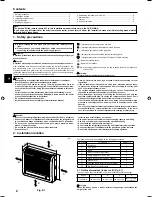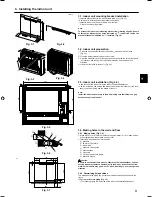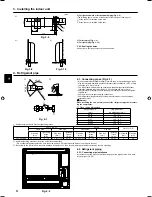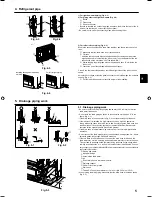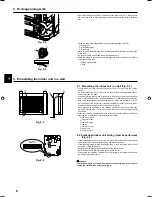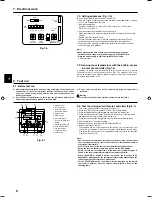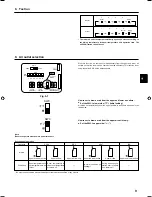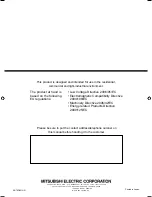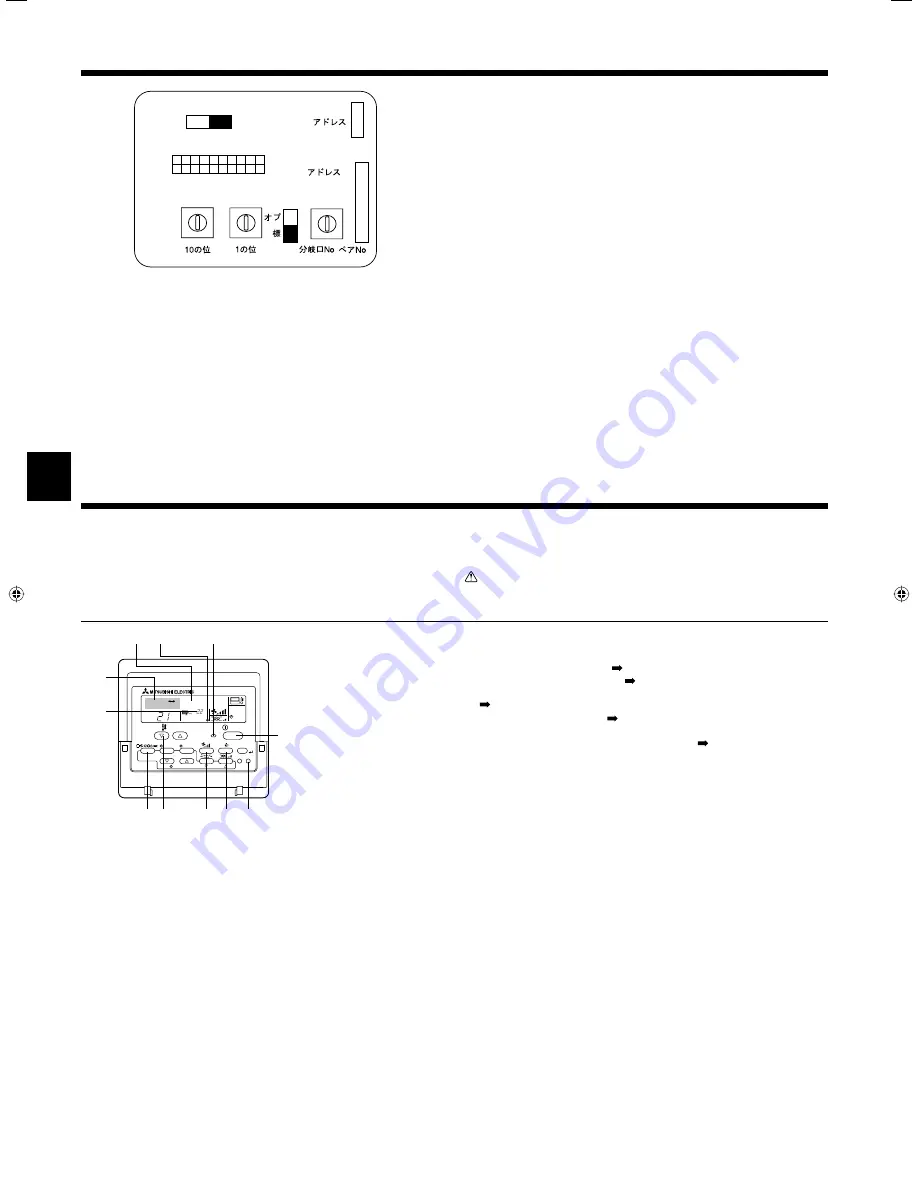
GB
8
1 2 3 4 5 6 7 8 9 10
ON
OFF
SW1
SW5
220V
240V
CN82
CN43
SW14
SWC
. /
.
(BRANCH No.)
0 12
3
4
5
67
89
AB
C
D
EF
SW11
SW12
0 1
2
3
4
5
6
7
8
9
0 1
2
3
4
5
6
7
8
9
(10ths DIGIT)
(1s DIGIT)
Fig. 7-4
7.5. Setting addresses (Fig. 7-4)
(Be sure to operate with the main power turned OFF.)
• There are 2 types of rotary switch setting available: setting addresses 1 to 9 and
over 10, and setting branch numbers.
1
How to set addresses
Example: If Address is “3”, remain SW12 (for over 10) at “0”, and match
SW11 (for 1 to 9) with “3”.
2
How to set branch numbers SW14 (Series R2 only)
Match the indoor unit’s refrigerant pipe with the BC controller’s end connection
number.
Remain other than series R2 at “0”.
• The rotary switches are all set to “0” when shipped from the factory. These
switches can be used to set unit addresses and branch numbers at will.
• The determination of indoor unit addresses varies with the system at site. Set
them referring to the Data Book.
Note:
Please set the switch SW5 according to the power supply voltage.
• Set SW5 to 240 V side when the power supply is 230 and 240 volts.
• When the power supply is 220 volts, set SW5 to 220 V side.
A
Address board
7.6. Sensing room temperature with the built-in sensor
in a remote controller (Fig.7-4)
If you want to sense room temperature with the built-in sensor in a remote
controller, set SW1-1 on the control board to “ON”. The setting of SW1-7 and
SW1-8 as necessary also makes it possible to adjust the air flow at a time when
the heating thermometer is OFF.
8.1. Before test run
►
After completing installation and the wiring and piping of the indoor and
outdoor units, check for refrigerant leakage, looseness in the power
supply or control wiring, wrong polarity, and no disconnection of one
phase in the supply.
►
Use a 500-volt megohmmeter to check that the resistance between the
power supply terminals and ground is at least 1.0 M
"
.
►
Do not carry out this test on the control wiring (low voltage circuit)
terminals.
Warning:
Do not use the air conditioner if the insulation resistance is less than 1.0 M
"
.
8.2. Test run (Using wired remote controller) (Fig 8-1)
1
Turn on the power at least 12 hours before the test run.
2
Press the [TEST] button twice. “TEST RUN” liquid crystal display
3
Press the [Mode selection] button. Make sure that wind is blown out.
4
Press the [Mode selection] button and switch to the cooling (or heating) mode.
Make sure that cold (or warm) wind is blown out.
5
Press the [Fan speed] button. Make sure that the wind speed is switched.
6
Check operation of the outdoor unit fan.
7
Release test run by pressing the [ON/OFF] button. Stop
8
Register a telephone number.
The telephone number of the repair shop, sales office, etc., to contact if an error
occurs can be registered in the remote controller. The telephone number will be
displayed when an error occurs. For registration procedures, refer to the operation
manual for the indoor unit.
Note:
• If an error code is displayed on the remote controller or if the air conditioner
does not operate properly, refer to the outdoor unit installation manual or
other technical materials.
• The OFF timer is set for the test run to automatically stop after 2 hours.
• During the test run, the time remaining is shown in the time display.
• During the test run, the temperature of the indoor unit refrigerant pipes is
shown in the room temperature display of the remote controller.
• When the VANE or LOUVER button is pressed, the message “NOT
AVAILABLE” may appear on the remote controller display depending on the
indoor unit model, but this is not a malfunction.
• For the PFFY-P•VKM series, the airflow direction displayed on the remote
controller is different from the actual airflow direction. Refer to the
following table.
ON/OFF button
Test run display
Indoor liquid pipe
temperature display
ON/OFF lamp
Power display
Error code display
Test run remaining time
display
Set temperature button
Mode selection button
Fan speed button
Air direction button
TEST button
SIMPLE
PAR-21MAA
ON/OFF
FILTER
CHECK
OPERATION
CLEAR
TEST
TEMP.
MENU
BACK
DAY
MONITOR/SET
CLOCK
ON/OFF
TEST RUN
COOL, HEAT
˚C
˚C
Fig. 8-1
8. Test run
7. Electrical work


